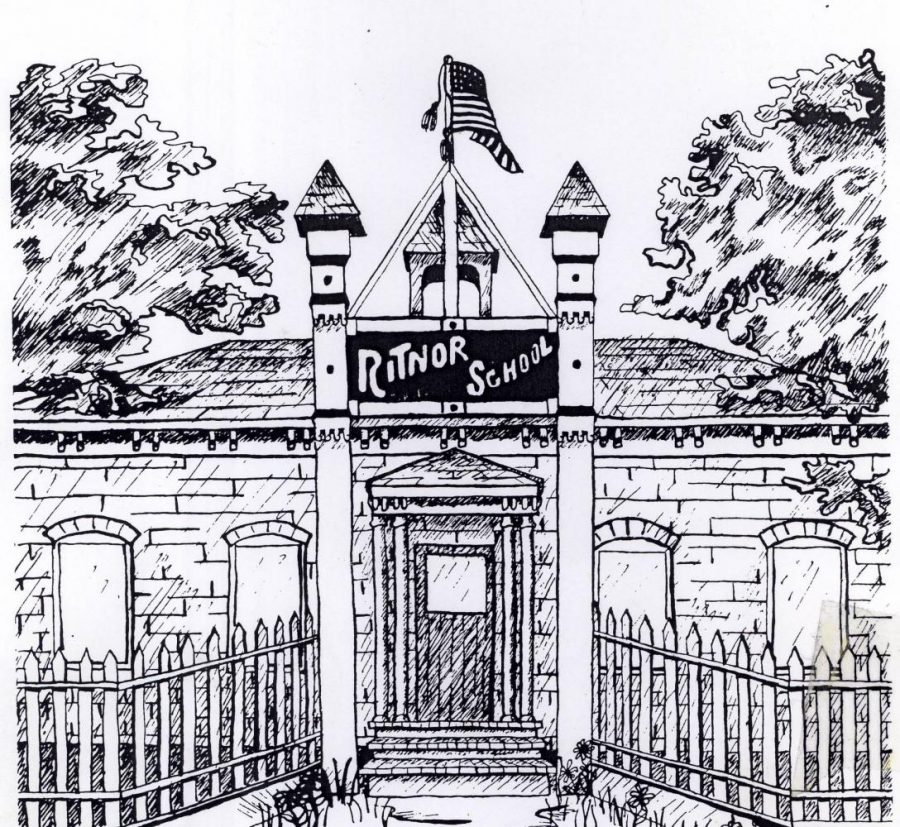Ritenour celebrates 150 years
October 10, 2017
Ritenour has reached the 150 year milestone, surpassing a century. Not only this, but this year’s graduates are the 100th class to receive their diplomas. The achievement is one for the books, or rather, the paper.
For over a century, Ritenour has been an integral part of Overland, and of its students’ lives. Rich with history, many who walk Ritenour’s halls and spend four years of their lives learning within it’s walls do not know it’s past.
For those who choose not to bulk down and take on the daunting task of reading the contents of “Ritenour… Our First 132 Years,” a booklet produced in 1978, here is a briefing of Ritenour’s history,
Beginning in 1846, the intersection of Woodson and Lackland, once green and sprawling, was where the slight, one room cabin stood that began the legacy of Ritenour School District. Though cited as having roots in 1867, Buck School, which later merged with Ritenour, is slightly more ancient than legend holds, starting in 1941. To give some perspective about the time period when the district first began, Honest Abe was only 37 years old, Queen Victoria had only reigned for nine years, and Dred Scott was still struggling in the fight for human rights.
As time progressed, the classroom welcomed more children, and the school house was brimming with students and promise. In 1867, Buck School became Ritenour, as it is more commonly known, after a wealthy landowner under the name of J.S. Ritenour passed away. The school was subsequently given his surname.
One major alteration in Ritenour is the ever continuing list of classes that are offered. In comparison to Buck School, Ritenour’s offerings are vast and varying. The meager list of classes that were taught in the original log cabin included grammar, arithmetic, geography, history, spelling, reading, mental arithmetic, pronunciation, and they ended with penmanship.
This isn’t the only drastic difference between the beginning of Ritenour and the present. When it first began, there were less than 100 students enrolled. In fact, the entirety of the school’s population could fit in the minuscule, one room cabin. In 1910, less than 50 years after Ritenour began its legacy, the amount of students jumped to 596. Now, however, enrollment has climbed to 1,860 students.
Resident Ritenour alum, Jerry Nolen has a slightly more modern take to the ever-shifting dynamic of Ritenour High School. As a former student, he has seen the school through the 70’s and into the 17’s—2017, that is.
He gave some insight into Ritenour during the 70’s. Not only was the auditorium not there, (it was built only five years ago) but the pool, library, and engineering rooms were not present. According to Nolen, the new rooms, completed during his senior year, were the only ones with air conditioning.
“You prayed that you got an air conditioned room,” Nolen said.
The lack of schoolrooms was surprising, but even more surprising is the fact that there were actually more students enrolled during the 70’s than there are now. Nolen recalled that there were a total of about 3,000 students. Compared to the current enrollment, that’s about 1,200 more students in the halls. However, compared to Buck School’s starting enrollment, 3,000 is a colossal number.
The layout of the school was not the only thing that is contrasting to present day Ritenour. Though it may sound surprising to students who lament the no hat rule or the requirement of two finger straps, the dress code was much stricter, especially for boys.
“Dress code was extremely different. You had to wear a belt. If you didn’t wear a belt, you either got sent home, or they had some belts and you had to wear it,” Nolen said.
The dress code isn’t the only thing that was more restrictive in past times. The classes that were offered, though arguably more varied than those originally offered at Buck School, were limited. There was no broad range of history, no innovative science classes, like ecology and botany, and certainly no engineering classes.
However, there were a number of classes that challenge current safety standards. Ritenour in the 70’s offered shop, which entailed welding and hot metal. It also gave students the opportunity to participate in the festive sport of archery, where students were taught the art of the bow and arrow.
The dynamic of Ritenour has shifted. From the size of the school, the students that inhabit it, and the rules that are implemented, and classes that are offered, Ritenour has transformed throughout the years. From Buck School in 1846, to the class of 2018, there is a span of a century.
The amount of electives and clubs that are offered now are more abundant than ever, giving students at Ritenour a myriad of opportunities and possibilities for learning.
Nolen said that students should take advantage of Ritenour at it’s prime, even if it is not yet at its peak.
“Join something,” Nolen said.


